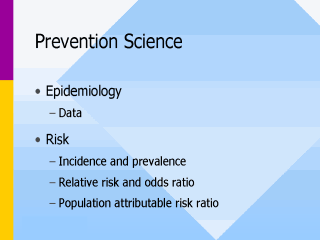| front |1 |2 |3 |4 |5 |6 |7 |8 |9 |10 |11 |12 |13 |14 |15 |16 |17 |18 |19 |20 |review |
 |
Prevention
Science clearly identifies what needs to be changed and validates both the reality and
magnitude of that change. A. Epidemiology is the study of: 1. Distributions (when, where, who, how many, how much) and 2. Determinants (how and why) of 3. Diseases, disorders, disabilities and 4. Desirable health events in... 5. Populations B. Risk: A major goal of epidemiology is to identify subgroups in the population that are at high risk for disease. 1. Incidence refers to the number of new cases and is changed by primary prevention. 2. Prevalence refers to the number of existing cases and is reduced by secondary prevention. 3. Risk is the probability that an event (e.g., development of a disease or disorder) will occur within a specific period of time. 4. Risk Ratio (also called Relative Risk) is the likelihood of a particular disease or disorder occurring among persons exposed to a given risk factor, divided by the corresponding likelihood among unexposed persons. Based on incidence data derived from cohort studies. 5. Odds Ratio (also known as Probability) is the odds of a particular exposure (risk factor) among persons with a specific disease or disorder divided by the corresponding odds of exposure among persons without the health condition of interest. 6. Population Attributable Risk Ratio is the percentage of the overall occurrence of a disease or disorder as an outcome within exposed persons that is related to the targeted exposure. Transition Point: There are several models of health care delivery that can assist the Speech-Language Pathologist or Audiologist in carrying out prevention activities... |